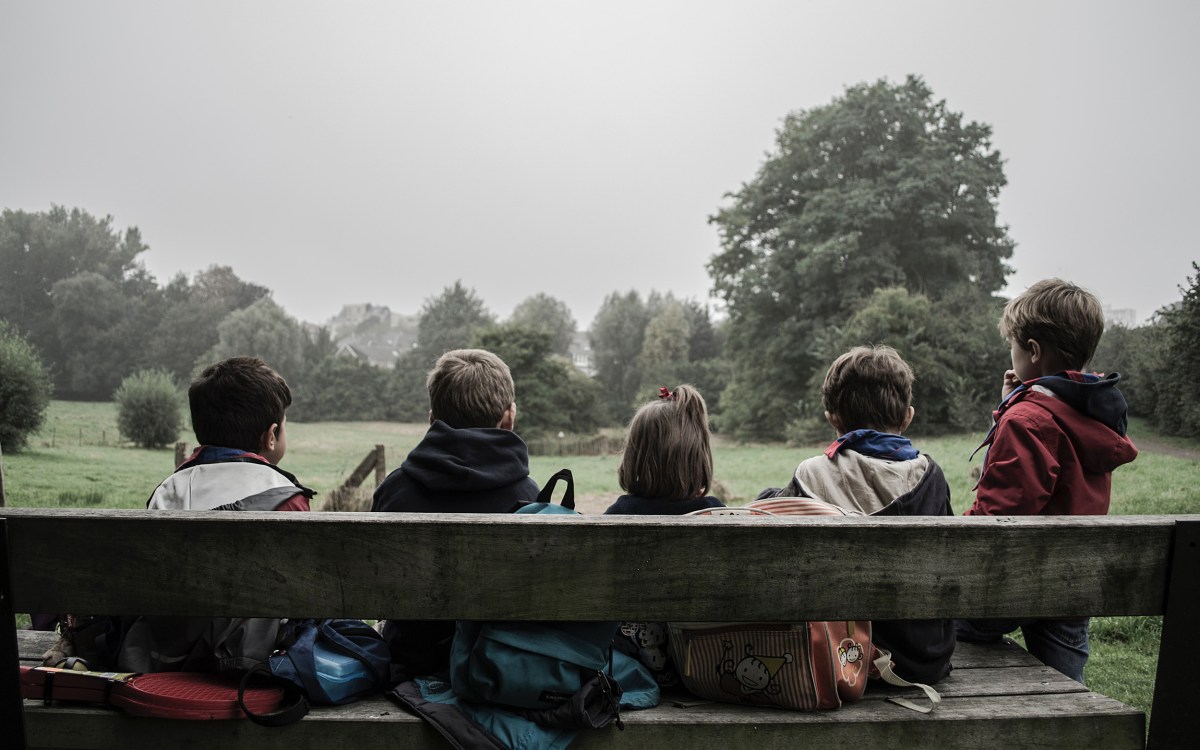
Urs Gasser and John Palfrey discuss how parents can manage children and their use of technology.
Stephanie Mitchell/Harvard Staff Photographer
Helping your child make the best use of time online
Experts offer advice on how to become a ‘connected parent’
Teenagers spend an average of nine hours a day online, and many parents worry about the impact of screen time on their children. There is no need to worry, said digital experts Urs Gasser and John Palfrey, authors of the newly released book “The Connected Parent: An Expert Guide to Parenting in a Digital World.” The Gazette spoke with Gasser, professor of practice at Harvard Law School and executive director of the Berkman Klein Center for Internet & Society, and Palfrey, president of the MacArthur Foundation and former faculty director of the center, on ways parents can embrace the philosophy of “connected parenting” and help children be safe online and make the most of new media and technology.
Q&A
Urs Gasser and John Palfrey
GAZETTE: What changes have you seen in the landscape of the new media and technology over the past 12 years since you published your book “Born Digital: Understanding the First Generation of Digital Natives” in 2008?
GASSER: A first change has to do with the types of technology young people are using to navigate the digital space. When we wrote “Born Digital,” smartphones were not a thing, and today they are the key device. Another change is the types of platforms young people are using and the issues that come up with these uses. Twelve years ago, for instance, there was a big challenge around music and entertainment; it was very hard for young people to find music online, and they got into trouble because they used file-sharing services to download their favorite tunes, which was illegal. Now that largely has been resolved by innovative business models, whether it’s Spotify or other platforms, where youth have music on the go, everywhere.
On the flip side, we’ve seen new issues emerging in the technology and business environments. One of the biggest concerns is around the use of [user behavioral] data, or what is called “surveillance capitalism.” Also, when we started our work, youth and technology was more like a niche topic, and that awareness has changed a lot. Parents are very concerned about issues such as screen time, and so are educators who are dealing with it in the face of COVID. It’s a general trend. Both policy- and lawmakers are thinking about youth and technology issues too — whether it’s about how we can mitigate some of the risks associated with it, but also how we can embrace the new opportunities that technologies offer to young people to engage in society and become participants in the digital economy.
5 keys to connected parenting
Keep an open conversation about digital issues.
Embrace the positive about new technology, while building skills to mitigate risks.
Seek a balance between offering support and independence.
Keep an open mind rather than fear new technologies.
Engage with the technology yourself so you can remain credible, model good behavior.
Source: “The Connected Parent: An Expert Guide to Parenting in a Digital World,” Urs Gasser and John Palfrey

Illustration by Claudia Thomas
GAZETTE: Can you explain your philosophy of “connected parenting”?
PALFREY: One thing that is distinctive about this book is that it presents the data and the advice we have for parents with a consistent philosophy. Anyone can go online and look up parenting advice tips. We think this book is helpful insofar as you embrace the philosophy of connected parenting. The ideas are very simple, but quite important and grounded in the research.
One is the importance of parents keeping the lines of conversation open with the young people in your life. This seems like an obvious point, but it is not always done, and it involves making sure that kids know that they can ask questions of you, in general, not just about technology.
That leads to a second point: We urge parents to get their hands dirty with the technology. We suggest that they use it to build credibility with their children. You don’t have to be on Snapchat all day long, or whatever is the latest technology at that moment, but you need to be credible for your advice to resonate with young people.
We also think that you should be led in your parenting not by fear, but by the data. And that’s what we hope to do through this book: to introduce what the real facts are relative to the research in the context of the most common questions that parents ask of us. It’s also about being open to the positive sides of the technology and the ways in which young people are learning and connecting to one another through these technologies.

GASSER: The only thing I would perhaps add is that parents need to connect with their kids first, and then connect with the technology.
GAZETTE: How have new media and technology affected parenting?
PALFREY: Most of the research has been looking specifically at the experiences that young people have, and the approach we’ve taken for the last 15 years at the Berkman Klein Center’s Youth and Media Lab has really been to ask the questions from the viewpoint of the young person. That is very important because it grounds the research in the realities of the child. We urge parents to focus on the lived experience of young people because our job as parents is important, but it is secondary to what they are experiencing. That’s really the most important takeaway.
I’ll take one specific example, which is bullying. People often talk about cyberbullying. Our argument is that while there is cyberbullying that happens online, there’s regular bullying that happens in the schoolyard. It’s actually all just bullying. It just plays out in multiple dimensions and in different environments. What we’re urging parents to do is to see them as connected, so if somebody is bullying somebody in the cafeteria, they’re probably also bullying them online and vice versa. The strategies to deal with bullying are going to be pretty similar in most cases. The research shows that most of the strategies that have worked for us historically in good parenting are going to hold up in this new world too.
GASSER: My sense is that parenting at its core is still similar to what we experienced in the offline age. But the rate of change that technology introduces is just a game-changer in many ways. The connected parent has to learn new things all the time to keep track of technological developments and understand how their children are using technology, with its risks and possible benefits. The very rapid pace of change creates a challenge for us parents because we have to make parental decisions without having the benefit of years of experience or advice from grandparents or evidence from researchers. I’ve experienced this challenge myself. As a parent, I feel I have to constantly learn, readjust, and figure out how can I empower my children: Where do I need to step in to protect them or what tools do we use to have these conversations?
GAZETTE: Could you talk about the importance of being a connected parent in this age?
PALFREY: If a parent abdicates in this area and doesn’t engage with young people on issues related to their technology use, then those parents are leaving their kids in a tough spot. Having hard conversations to help a young person navigate a world where they have a device connected to them 24/7 is literally necessary. Partly what we’re saying to parents is that they should jump on in because the water is fine, and it is going to be OK. You don’t get a manual for how to be a parent when a child is born; you just do some version of what you’ve learned from those who raised you, and you might adjust in one direction or another. But that doesn’t exist in this case because there is a generational turn, and what you don’t want to do is to leave kids on their own. We hope this book can serve as that “missing manual” for parents in this case.
GAZETTE: Most parents are scared and worried about the impact of technology in their children’s lives. What are the most common misconceptions about the influence of new media and technology?
GASSER: Adults often underestimate how integrated digital technologies are in the lives of young people. As adults, we still tend to make a distinction between “online” and “offline,” and yet, for young people, these distinctions are no longer meaningful. Both the interconnectedness and the embeddedness of digital technology shape the lives of young people in profound ways.

At the same time, there is a notion among adults that young people are tech-savvy because it’s in their DNA or because they’re young and interact with technology all the time. We know from research, however, that there are serious participation gaps. Not all children have access to digital technologies in the same way. These gaps are persistent here in the U.S. We also see big differences in the distribution of the skills that are needed to use these technologies in a meaningful way. There are really big equity issues, and we, as adults, have a deep responsibility to ensure that we put policies in place that allow every young person to access technology and use it in a productive way.
PALFREY: One reason for writing this book and our previous book, “Born Digital,” before that, is the number of myths that pervade adult understanding of how young people are growing up. We consider our work to be myth-busting work because there are many myths that make parents underestimate the positives that young people can get from their experiences with new media as well as the actual contours of the dangers they face. One thing we always say is that for young people there is not an offline life and an online life; it’s just life.
Among the positive aspects of technology is the high levels of civic activism among young people in the United States and in different parts of the world. This is connected in many ways to the kinds of things that they are able to do through technology and new media and the sense of agency young people have relative to new technologies. They can start new organizations and are able to spread the word across geographic boundaries. I would highlight the Black Lives Matter protests, which have grown in part through a networked set of technologies.
Another example is climate activism, which has spread throughout the United States and other places globally in part because of the internet. Some people it’s just “clicktivism” because they’re just clicking “likes” on Facebook. That’s not seeing the fullness of the ways in which young people are using technology and how it does shift the way they engage with the world.
GAZETTE: Some people worry that the internet is making people dumber. Is that a myth?
PALFREY: I don’t think there’s anything in the research that says that this is a dumber generation. It made for a clever book title (“The Dumbest Generation”) that sold a lot of copies, but I do not think there is merit in the data. There are certainly questions about the long-term effects of the extensive technology use on young people’s learning, but as with other things, I wouldn’t blame the technology itself. It’s the way in which we use it and choose to use it. I, for one, believe this is going to be the most educated generation in history, not the dumbest generation in history. We’ll see.
GAZETTE: Your book says that teenagers spend an average of nine hours per day online. What does the research say about the impact of so much screen time on young people? What is your advice to parents?
GASSER: The important point is that how much time young people spend online matters. When it comes to screen time, perhaps surprisingly, studies suggest that moderate use of technology can have actually a positive impact on the social and emotional well-being of young people. The problem appears with excessive time spent in front of screens. A particular area of concern is sleep, because often kids who use technology in excessive ways don’t sleep enough. The difficulty is to determine what the right amount of screen time is, and that depends on the age range. Our book offers some guidance based on research. However, the biggest insight from research is that what matters is not only how many hours someone spends in front of screens, but what type of activities is the young person engaging with. For instance, if a kid uses a cellphone, does she use it for gaming? If so, what kinds of games is she playing? Or does she use it to communicate with her friends, to engage in some types of activism, or does she use it to do her homework and learn online in the time of COVID? All these types of activities can have a different impact on the young person’s well-being and development, and future research will look into these qualitative questions.
PALFREY: The most important thing about screen time is quality versus quantity. It’s especially important when it comes to this moment of COVID-19 because with students being out of school, they are connected to other people through their devices almost exclusively. The debate over screen time has therefore changed enormously. It used to be adults being concerned that kids were spending too much time online, but there’s no choice during COVID. It fortunately lines up with the research that shows that the qualitative point is more important than the quantitative.
GAZETTE: What are the real effects of social media and screen time in the increase in depression and anxiety among young people?
PALFREY: The research is telling us that there is an increase for many young people in stress, anxiety, depression, and suicidality in general. We also know that kids are using technology more than before. We do not know that there is a causal link between those two. It’s important, as researchers, to say the things that we do know and the things we don’t know. A hypothesis is that the technology can exacerbate conditions that young people have. An example is an eating disorder, which can be an extreme form of anxiety, obsessive compulsive disorder, and so forth, a young person might be prone to by genetics and by environment to have this disorder. When they go on Instagram and they see the most beautiful and skinny version of everybody else, they might internalize that as part of the anxiety they’re having. In cases like that, technology can exacerbate underlying situations, but they don’t cause it. The challenge is having to parse things out and respond appropriately given each person’s situation.
“Both young people and digital technology are better than their reputation.”
Urs Gasser
GASSER: Research also shows that kids with moderate anxieties can actually benefit and find support in social media, as a way to cope with their challenges. There is a positive role that social media can play in not only being part of a complex problem, but part of the solution.
GAZETTE: What can parents do to keep their children safe online?
GASSER: The easiest point is parents should start by respecting their children’s privacy. We see lots of parents posting baby pictures on Facebook, and as kids grew up, they continue to use social media to share cute pictures with their friends, which is understandable. But this raises privacy concerns as the young person grows older. There are conversations that need to happen over time between parents and young people about sharing of particularly sensitive data, so that kids develop an awareness about what happens if you post a selfie or a snapshot of your friends on social media that later may be part of your children’s digital dossier and may be seen by their school admission’s office. Perhaps that’s the hardest part for adults and parents, but we need to understand what is going on with all the data and the traces we leave online as we use these technologies. That goes back to the topic of surveillance capitalism mentioned earlier. Parents or young people are limited by what they can do to safeguard their privacy. That’s where legislators and governments have to step in and provide, particularly here in the U.S., more robust privacy and data protection and safeguards for young people and adults. The Europeans are ahead of us, and we need desperately to catch up.
PALFREY: A few additional words about safety. We’ve been led to believe that the rate of harm to young people has gone way up during the internet era. But it turns out that the data suggest quite the opposite, which is that children are less likely to be physically or sexually harmed by a stranger they meet outside the home over the last few decades, during the growth of these technologies. That’s not to say that young people can’t get in trouble online, whether that’s in a chat function of a game or in an edgy web community that is devoted to sex, for instance. These are areas where certainly young people can connect with people who wish to do them harm. Ensuring that parents are giving good advice to young people about the way they engage with others remains important.
GAZETTE: What do you think is the main takeaway from your book?
GASSER: If I could say it in a tweet, I would say this: Both young people and digital technology are better than their reputation.
This interview has been condensed and lightly edited for length and clarity.








